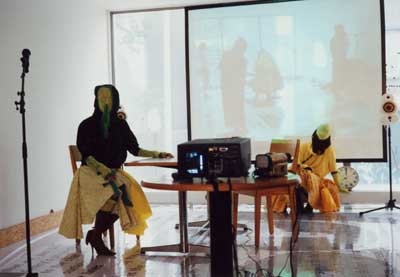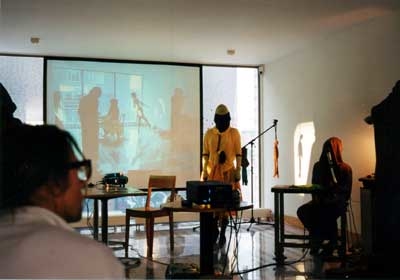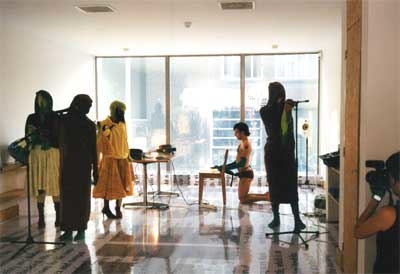
And the best thing about it is that for the time being, there's really nothing else like it going on in the art world, a fact that the contemporary avant-garde doesn't seem to grasp very well. Okay, maybe Matthew Barney is the only one on par with Butler; maybe Barney is his only true contemporary.
Though trained as a dancer and choreographer, you really have to see Butler as a typical visual artist. In all of his productions, you're forced to confront the fact that you're seeing someone who's attempting to create the aura of classical visual art. But because he tends to situate his work in a multimedia environment, you don't notice this right away. At first you think: here's a typical postmodern choreographer. But very soon you realize that something's awry. It's as if he creates a special atmosphere around his work that shields his true intentions from out all too prying eyes. He deceives you into thinking you're going in one direction, until you realize that he's after just the opposite, and wants you to see what it is he seems to be showing. First it seems as if he wants his choreographies to protect him from the multimedia attacks of contemporary art, but then you see how he's attempting to transform the limited two-dimensionality of painting, photography and video - and even the three-dimensionality of sculpture - into a kind of artistically venerable multi-dimensionality. When he touches the human body, he imbues it with an artistic dimension that forms a very personal contribution to contemporary discourse.

And how does his contribution look? Remarkable. Because however postmodern and truly contemporary his choreographies may be, they're fed at they same time by a look back at the academic art of the end of the 19th century, a period neglected for far too long, and a time during which no direct contact was maintained with the then-exalted art - that of the Greeks. Instead, the past was contemplated and idealized via plaster statues. In many ways, Butler has the same way of connecting with the past, except that for him it's not a Greek but rather a Far Eastern ambience that plays an important role. And it's not plaster statues but rather living bodies that create this contact with an idealized past. And it's by taking advantage of the differences between sculptural figures and choreographed bodies that the essence of Butler's work exists. When he has his sculptural choreography unfold in a holistic environment, it's immediately undermined by humor in a "gotcha" kind of relativization. But, despite appearances to the contrary, Butler has none of the indecisiveness of the zapper: he is clearly propagating a philosophy of life. He is in the process of building a visual language that needs time to become visible in all its facets. A pretty face, someone who really takes the time - and the space! - to work out the specifics of his vision, but stops short of too easily exposing its underlying philosophy.

Butler has a lucid strategy: he choreographs like a chess player plays chess. In the structure of the sequential moves, he makes a clear effort to give his opponent a role: sometimes he plays both parts himself, sometimes the dancers are the opponents, and sometimes he plays against the audience. At the same time, he also choreographs like a composer composes: namely, a classical composer with an almost 19th century approach, as he uses his ultramodern improvisations for a more comprehensive syntax. The compositions have an almost classical allure: they all contribute to an edifice that you can really only call visual.
Let there be no mistake: Butler is a visual artist who gives us the images that we truly and woefully need. With a lot of verve, he sends us though a spiritual universe where images move and are then removed from view. And that yields true experience. The most beautiful thing I remember was the moment when I suddenly saw an illustration of an eminently classical philosopher. A dancer briefly stood still, and for a moment nothing moved, although everything was in motion: I believed that I had truly seen the ultimate illustration of one of the most curious philosophers of all time: Thomas Aquinas, who discusses, in his first Proof of God, the immovable mover.
translation douglas heingartner